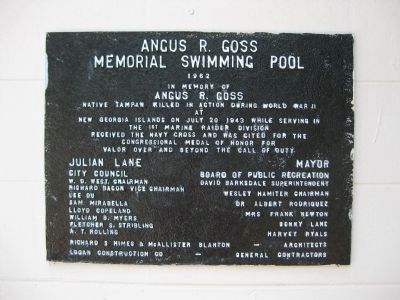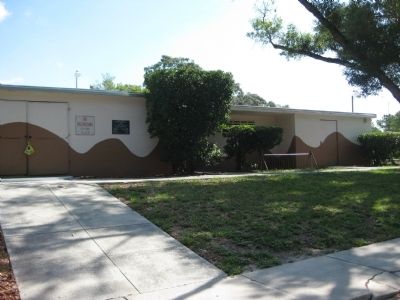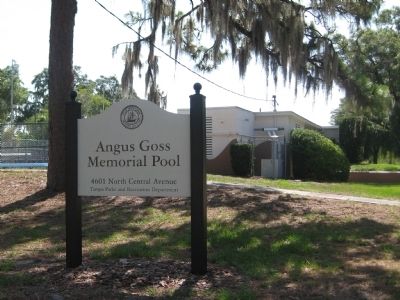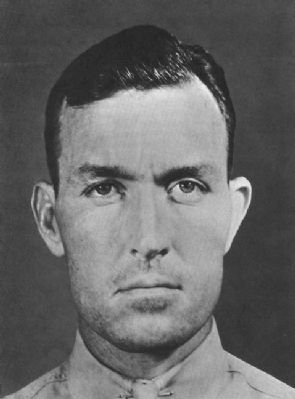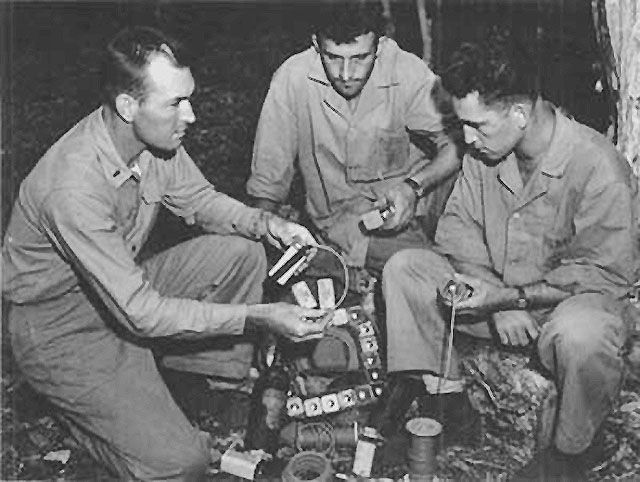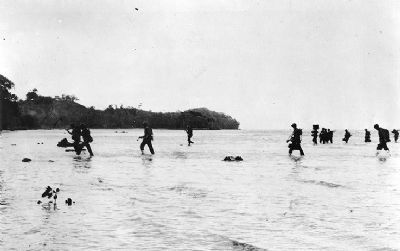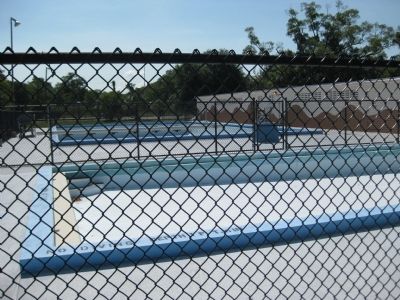Tampa in Hillsborough County, Florida — The American South (South Atlantic)
Angus R. Goss
Memorial Swimming Pool
— 1962 —
Inscription.
Angus R. Goss
Native Tampan, killed in action during World War II
at
New Georgia Islands on July 20, 1943 while serving in
the 1st Marine Raider Division
Received the Navy Cross and was cited for the
Congressional Medal of Honor for
valor over and beyond the call of duty
Julian Lane Mayor
City Council
W. D. West Chairman • Richard Bacon Vice Chairman • Lee Du • Sam Mirabella • Lloyd Copeland • William B. Myers • Fletcher S. Stribling • A. T. Rollins
Board of Public Recreation
David Barksdale Superintendent • Wesley Hamiter Chairman • Dr. Albert Rodriguez • Mrs. Frank Newton • Benny Lane • Harvey Ryals
Richard S. Himes & McAllister Blanton - Architects
Logan Construction Co - General Contractors
Erected 1962.
Topics and series. This historical marker is listed in these topic lists: Patriots & Patriotism • War, World II. In addition, it is included in the Distinguished Service Cross/Navy Cross/Air Force Cross Recipients series list. A significant historical date for this entry is July 20, 1943.
Location. 27° 59.23′ N, 82° 27.281′ W. Marker is in Tampa, Florida, in Hillsborough County. Marker is on East Cayuga Street east of North Central Avenue, on the left when traveling east. The marker is affixed to south wall of the pool facility building. Touch for map. Marker is at or near this postal address: 4601 North Central Avenue, Tampa FL 33603, United States of America. Touch for directions.
Other nearby markers. At least 8 other markers are within 2 miles of this marker, measured as the crow flies. St. Mary’s Catholic Cemetery (approx. ¾ mile away); Old People's Home (approx. 1.2 miles away); Middleton Senior High School (approx. 1.3 miles away); Cyrus Greene Park (approx. 1.3 miles away); The Buffalo Soldiers in Tampa Heights (approx. 1.4 miles away); Hillsborough County High School (approx. 1.4 miles away); George Washington Junior High School (approx. 1.4 miles away); Cueto Boarding House (approx. 1½ miles away). Touch for a list and map of all markers in Tampa.
More about this marker. The Angus Goss Memorial Pool was built as a city park featuring a standard olympic-size pool for adult use, and a smaller, shallow kiddie-pool. For nearly 60 years, it served as one of Tampa's public outdoor recreation facilities. As of 2010, the Tampa Parks and Recreation Department listed the pool's status as "permanently closed".
Regarding Angus R. Goss. Angus R. Goss was born in Tampa, Florida, on January 8, 1910. Angus inherited a strong working ethic from his father, Jacob Goss, and helped at the family's grocery store during
his childhood. Angus became the first of his family to achieve a high school diploma, graduating from Hillsborough High School (only a few hundred feet north of this marker). Despite this, he found few jobs available as the Great Depression began; so in 1930, at the age of 20, he enlisted in the United States Marine Corps.
As a Marine, Goss would become widely respected for his dedication and professionalism, and he rose to the rank of Marine Gunner. He joined the 1st Marine Raider Battalion as a demolitions expert, and was assigned to duty in the Pacific during World War II.
During the Battle of Tulagi, the Raiders were charged with liberating the tiny island, part of the Florida Islands group. Tulagi had served as the capital of the Solomon Islands Protectorate until 1942, when it was invaded by Japanese forces, who occupied the island and set up a seaplane base. On August 7th, Goss's 1st Raiders and another Raider battalion landed on the island, taking the enemy by surprise. The Japanese fell back, retreating deeply inside limestone caves and protected bunkers which they defended with machine guns. The Raiders had no bazookas or similar propelled weaponry, so it fell to their demolition platoon to flush out the enemy with explosives. Goss, as platoon sergeant, spurred his men on through the careful construction of "Bangalore torpedoes" and devices of
similar volatility. Given that their improvised arsenal had to be manually delivered to their intended targets, their slow-going offensive over the next few days was delicate, deliberate, and by any definition, daring.
By August 10th, the Marines had successfully liberated the island from its Japanese invaders, with the exception of an entrenched few who were holed up inside positions from which their removal seemed particularly challenging. In this moment, especially, Marine Gunner Goss proved equal to the task, pulling from an inherent abundance of courage, stealth, and ingenuity. With such traits, he was able to successfully detonate a live, time-fused explosive inside a cave on a particularly steep cliff-side by first scaling the cliff and lowering the bomb from above with a long rope, which by swinging, he then delivered the package into its target, right at the crucial moment.
Goss's most celebrated battlefield moment involved a cave which afforded its Japanese occupants a rocky parapet for added defense. Goss managed to conceal his approach until he was close enough to lob a two blocks of TNT directly into his target. What followed, Goss would later recount, stating, "the Japs threw it back at me. It exploded behind me and blew the debris - wood, wire and gravel into my leg."
Another Marine managed to pull Goss behind cover, hoping to then apply first aid. The injured party, however, had different plans. Incensed, Goss grabbed a sub-machine gun, hobbled his way to the cave, and clambered up the parapet with no concern for his personal safety. Goss then took out every one of his astonished opponents.
For his incredible valor during this battle, Marine Gunner Angus Goss was nominated by his division commander for the Congressional Medal of Honor, a nomination which was promptly seconded by General Alexander Vandegrift and Allied forces Pacific commander-in-chief, Admiral Chester Nimitz. Unfortunately, it would take almost a year before the stateside Board of Awards would evaluate the nomination, which ultimately, they did not approve. Instead, they conferred upon Angus R. Goss the Navy Cross medal in July, 1943. Around the same time, he was confirmed to receive another award, the Conspicuous Gallantry Medal, awarded for gallantry in the field by the government of the United Kingdom. Tragically, Goss would never learn of his accolades. He was killed during battle on the island of New Georgia on July 20, 1943. Angus Goss was buried at the Manila American Cemetery and Memorial in the Philippines.
The U.S. Navy would later name a destroyer escort in Goss's memory. The U.S.S. Goss saw heavy combat in the Pacific the later years of World War II, and would receive four battle
stars. The ship also served during the Korean War.
Source of information: Alexander, Joseph. "Edson's Raiders: the 1st Marine Raider Battalion in World War II", Naval Institute Press, 2000.
Credits. This page was last revised on June 16, 2016. It was originally submitted on June 27, 2011, by Glenn Sheffield of Tampa, Florida. This page has been viewed 1,923 times since then and 29 times this year. Photos: 1, 2, 3, 4, 5, 6, 7. submitted on June 27, 2011, by Glenn Sheffield of Tampa, Florida. • Bernard Fisher was the editor who published this page.
